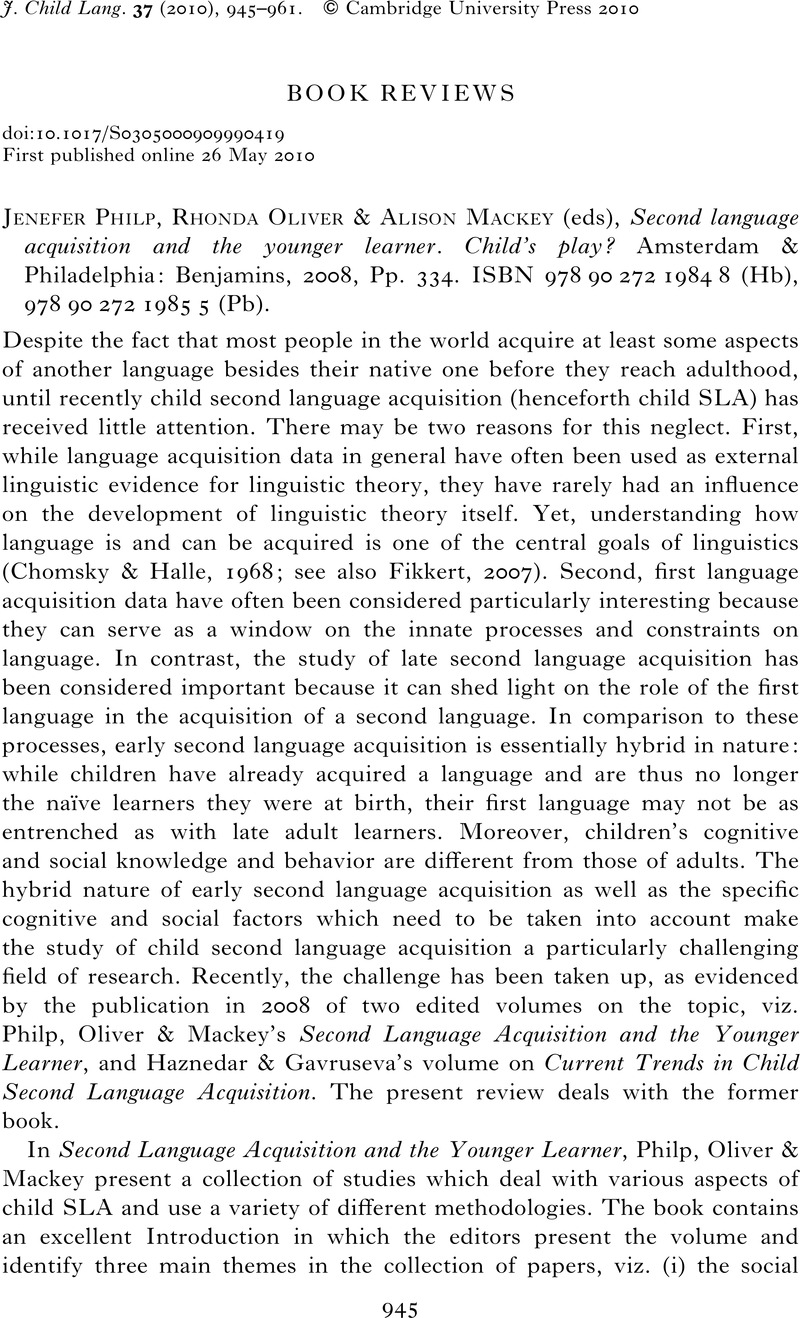No CrossRef data available.
Article contents
Jenefer Philp, Rhonda Oliver & Alison Mackey (eds), Second language acquisition and the younger learner. Child's play?Amsterdam & Philadelphia: Benjamins, 2008, Pp. 334. ISBN 978 90 272 1984 8 (Hb), 978 90 272 1985 5 (Pb).
Published online by Cambridge University Press: 26 May 2010
Abstract
An abstract is not available for this content so a preview has been provided. Please use the Get access link above for information on how to access this content.

- Type
- Book Review
- Information
- Copyright
- Copyright © Cambridge University Press 2010
References
REFERENCES
Anglin, J. M. (1993). Vocabulary development: A morphological analysis. Monographs of the Society for Research in Child Development 58(10), 1–165.Google Scholar
Bloch, C., Kaiser, A., Kuenzli, E., Zappatore, D., Haller, S., Franceschinid, R., Luedi, G., Radue, E.-W. & Nitsch, C. (2009). The age of second language acquisition determines the variability in activation elicited by narration in three languages in Broca's and Wernicke's area. Neuropsychologia 47, 625–33.CrossRefGoogle ScholarPubMed
Cenoz, J., Hufeisen, B. & Jessner, U. (eds). (2001). Cross-linguistic influence in third language acquisition: Psycholinguistic perspectives. Bristol: Multilingual Matters.CrossRefGoogle Scholar
Dewaele, J.-M., Petrides, K. V. & Furnham, A. (2008). Effects of trait emotional intelligence and sociobiographical variables on communicative anxiety and foreign language anxiety among adult multilinguals: A review and empirical investigation. Language Learning 58(4), 911–60.Google Scholar
Fikkert, P. (2007). Acquiring phonology. In de Lacy, P. (ed.), The Cambridge Handbook of phonology, 537–54. New York: Cambridge University Press.CrossRefGoogle Scholar
Foster-Cohen, S. (1999). SLA and first language acquisition. Annual Review of Applied Linguistics 19, 3–21.Google Scholar
Goswami, U., Ziegler, J. C. & Richardson, U. (2005). The effects of spelling consistency on phonological awareness: A comparison of English and German. Journal of Experimental Child Psychology 92, 345–65.CrossRefGoogle ScholarPubMed
Haznedar, B. & Gavruseva, E. (2008). Current trends in child second language acquisition. A generative perspective. Amsterdam: John Benjamins.Google Scholar
Horwitz, E. K. (1988). The beliefs about language learning of beginning university foreign language students. The Modern Language Journal 72(3): 283–94.Google Scholar
Kolb, A. (2007). How languages are learnt: Primary children's language learning beliefs. Innovation in Language Learning and Teaching 1(2), 227–41.Google Scholar
McLaughlin, B. (1989). Second-language acquisition in childhood, Vol. 1. Preschool children, 2nd edn.Hillsdale, NJ: Lawrence Erlbaum Associates.Google Scholar
Moyer, A. (2009). Input as a critical means to an end: Quantity and quality of experience in L2 phonological attainment. In Piske, T. & Young-Scholten, M. (eds), Input matters in SLA, 159–74. Bristol: Multilingual Matters.Google Scholar
Odlin, T. (1989). Language transfer: Cross-linguistic influence in language learning. Cambridge: Cambridge University Press.CrossRefGoogle Scholar
Pienemann, M. (1998). Language processing and second language development: Processability theory. Amsterdam: John Benjamins.Google Scholar
Ringbom, H. (2007). Cross-linguistic similarity in foreign language learning. Bristol: Multingual Matters.Google Scholar
Wenden, A. L. (1999). Commentary: An introduction to metacognitive knowledge and beliefs in language learning: Beyond the basics. System 27, 435–41.Google Scholar


